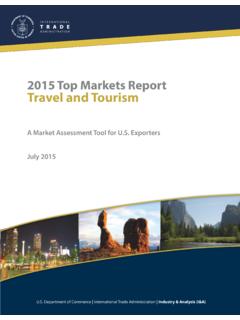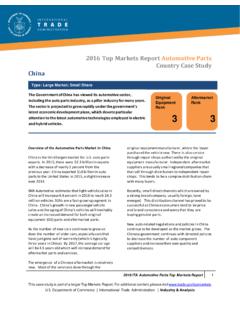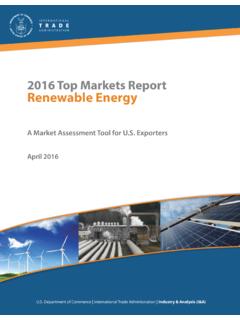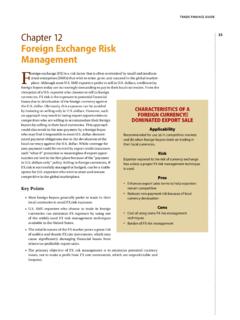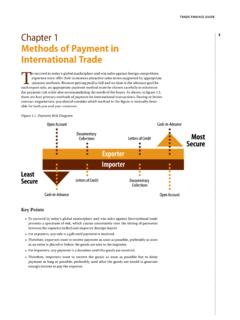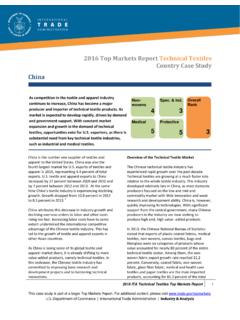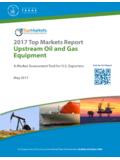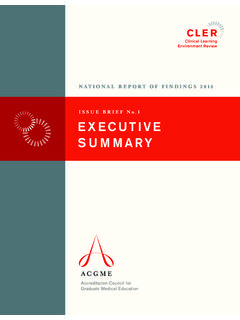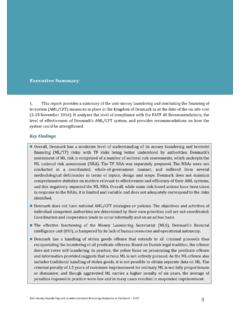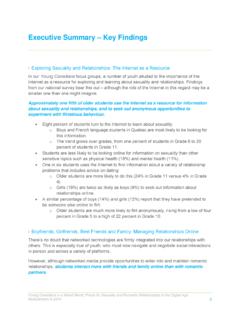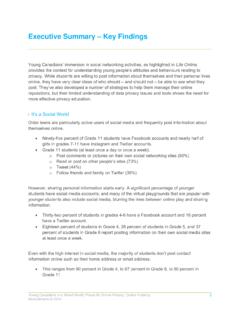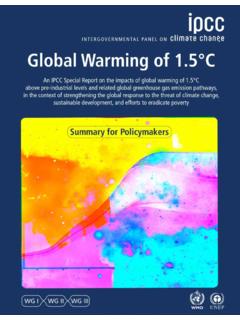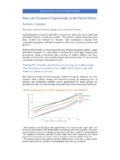Transcription of Executive Summary and Key Findings
1 2015 ITA Travel and Tourism Top Markets Report 3 Executive Summary and Key Findings The global growth of outbound travel represents an unprecedented opportunity to increase travel and tourism exports. According to the United Nations World Tourism Organization (UNWTO), international visitors spent an estimated $ trillion globally on travel and tourism in 2013. However, the share of global expenditures has declined over the last decade. With so much revenue at stake, governments around the world are trying to lure would-be travelers to their countries with facilitative policies and aggressive marketing.
2 As incomes around the world continue to rise and the demand for travel and tourism continues to grow, so too, will the competition for international arrivals and spending. Few industries have the job-creating potential seen with the travel and tourism industry, so focusing efforts on these top markets could pay tremendous dividends. As one of America s largest employers, the travel and tourism industry is profoundly important to the economy. Travel and tourism has grown into a $ trillion industry that supports nearly million jobs, million of which are supported by travel and tourism-related exports.
3 Indeed, one out of every 18 Americans is employed by travel and tourism-related businessesi, businesses that pay out more than $220 billion in employee compensation each Everyone benefits from travel and tourism, not just the travel and tourism industry. Travelers and their spending help support local communities and small businesses; schools, banks, and infrastructure; farms, museums, shopping malls and family-owned restaurants. Travel and tourism generates billions in local, state, and federal taxes, nearly $1,100 per Quite simply, travel and tourism supports America.
4 Each day in the United States, international visitors inject more than $588 million into the economy while experiencing all that America has to offer. In fact, international visitors spent a record-breaking $215 billion in the United States in 2013, an increase of more than seven percent when compared to 2012. Conversely, residents spent an estimated $137 billion abroad in 2013, resulting in a balance of trade surplus of more than $78 billion the 25th consecutive year that the United States has enjoyed a favorable balance of trade for travel and tourism.
5 Travel and tourism has become a significant industry in trade. Travel and tourism exports now account for nearly one-third (31 percent) of all services exports and more than nine percent of all exports, positioning travel and tourism as America s largest services producing industry. Every one dollar spent directly on travel and tourism-related goods and services generates an additional $ of output in ancillary industries ( , toiletries for hotel guests, fuel for airplanes, linens for restaurants); therefore, an additional $10 billion in tourism spending could translate into an additional $ billion for the economy.
6 Market Intelligence: Understanding the Overseas Traveler Here is what we know about overseas travelers to the United States: Regions and Countries of Origin Nearly 38 percent of all overseas arrivals in the United States came from Western Europe in 2013, followed by Asia (28 percent), South America (16 percent), Oceania (four percent), and the Caribbean (four percent). The Middle East, Eastern Europe, and Central America each accounted for three percent of overseas arrivals, while Africa accounted for the fewest overseas arrivals (one percent). The United Kingdom produced the largest number of overseas arrivals ( million), followed by Japan ( million), Brazil ( million), Germany ( Figure 1: Projected Top Markets for Travel and Tourism Australia11.)
7 India 2015 ITA Travel and Tourism Top Markets Report 4 million), and China ( million) rounding out the top five overseas origin markets in terms of arrivals, or 42 percent of all overseas arrivals. Ports of Entry New York, New York was the top port of entry used by overseas travelers visiting the United States in 2013, welcoming 18 percent of all overseas arrivals. New York was followed by Miami, Florida (15 percent), Los Angeles, California (10 percent), Honolulu, Hawaii (seven percent), and Newark, New Jersey (six percent). These five ports of entry cumulatively account for more than half (56 percent) of all overseas arrivals to the United States.
8 Purpose of Trip As to the main purpose of their trip to the United States, the majority of overseas arrivals reported they were on vacation or holiday (57 percent), followed by visiting friends and relatives (17 percent), business (12 percent), convention/conference/trade show (seven percent), and education (five percent). When considering all purposes of their trip (multiple responses), the net purpose of business and leisure totaled 22 percent and 79 percent, respectively. Destinations Visited: States and Cities New York was by far the most popular state visited by overseas travelers, having welcomed nearly one-third (31 percent) of all overseas visitors in 2013, followed by Florida (23 percent), California (20 percent), Hawaii (10 percent), and Nevada (nine percent).
9 The cities most frequented by overseas visitors in 2013 included New York City (30 percent), Miami (13 percent), Los Angeles-Long Beach (12 percent), Orlando (12 percent), and San Francisco (10 percent). Number of States Visited The overwhelming majority (72 percent) of overseas travelers visited only one state during their stay in the United States; slightly more than 16 percent visited two states; and 12 percent of overseas travelers visited three or more states. Intuitively, the data suggest that those who have been here before (repeat visitors) were most likely to visit one state; first-time visitors, however, were more mobile and more likely to visit more than one state during their stay.
10 Leisure Activities The top leisure activities of overseas visitors are shopping (88 percent), sightseeing (77 percent), experiencing fine dining (39 percent), visiting national parks and monuments (34 percent), visiting art galleries and/or museums (28 percent), visiting amusement/theme parks (28 percent), traveling to historical locations (27 percent), traveling to small towns/countryside (27 percent), guided tours (24 percent), and attending concerts/plays/musicals (18 percent). Some other activities with double-digit participation rates include visiting cultural/ethnic heritage sites (16 percent), nightclubbing/dancing (16 percent), sporting events (13 percent), and water sports (10 percent).

